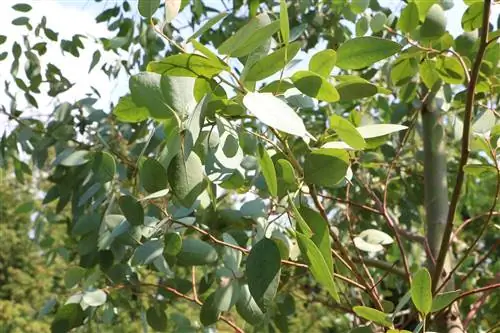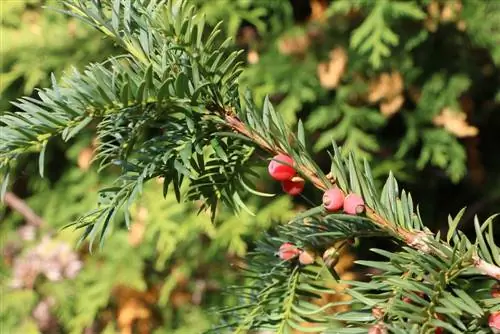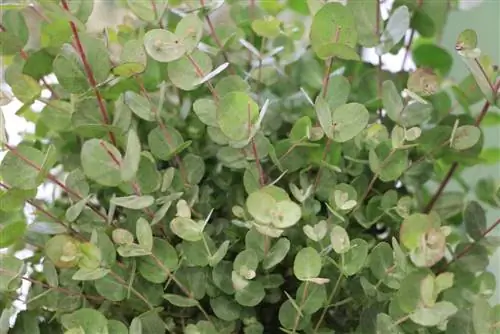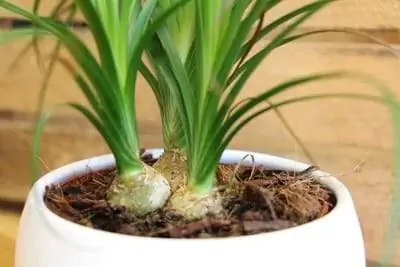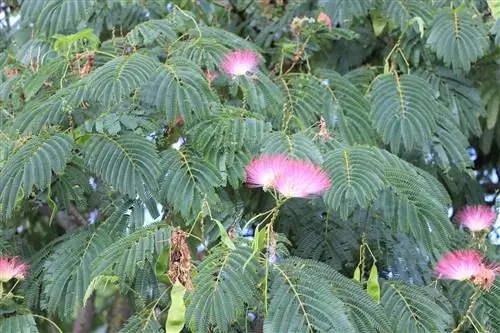- Author admin [email protected].
- Public 2023-12-17 03:39.
- Last modified 2025-01-24 12:45.
Eucalyptus is not only an important medicine, but also a staple food for koala bears. They love the aromatic leaves and chew them with great devotion every day. Since koalas can only be admired in zoos in our latitudes, the eucalyptus tree is grown more for medical reasons and for aesthetic reasons. Because a eucalyptus tree or shrub is beautiful to look at.
The evergreen shrub or tree offers many essential oils that promise healing, especially for respiratory diseases. The oils also keep annoying mosquitoes away, which is particularly pleasant in the summer months. But the eucalyptus tree also looks quite impressive. In spring, its strong green leaves are joined by flowers that can sprout in the colors yellow, red or white.
Plants
Eucalyptus can grow as a tree or as a shrub. It belongs to the myrtle plant family and has leaves all year round. With appropriate care and an ideal location, the trees can grow up to 100 meters high. Shrubs, on the other hand, expand a lot in width and require appropriate space.
More than 600 species of eucalyptus trees are counted worldwide. The plant originates from Indonesia and Australia. To date, only a few species have been able to be cultivated in our latitudes. These include the Eucalyptus Regnans and the Eucalyptus Gunni. In order to be able to plant eucalyptus successfully, it is important that there is enough space. The roots of the plants penetrate quite deeply into the soil. They also tend to spread, which can become a problem for neighboring plants. The shrub or tree could rob the plants of water and nutrients and thereby prevent them from growing. For this reason, it is always recommended to provide a root barrier around the eucalyptus tree so that neighboring plants are not damaged. The following should also be taken into account when planting:
- The eucalyptus tree needs loose soil
- Old root residues should be thoroughly removed from the soil
- Fresh compost should be added to the planting hole
- Water the root ball thoroughly before placing it in the planting hole
- place the tree or shrub on a drainage system made of gravel and sand so that no waterlogging can form
Tip:
In order for the eucalyptus to thrive, it needs soil that is as low in lime and rich in nutrients as possible. If it is to be planted in a container, sand and rhododendron soil can be used.
Care
Eucalyptus comes from tropical regions and requires appropriate care. Whether this is watering, trimming or fertilizing: If you don't take care of your eucalyptus, you will only be able to enjoy it to a limited extent.
Pouring
Nothing grows without water. Since the plant is used to a warm and humid climate due to its origin, the eucalyptus should be watered regularly. It is therefore important that it is always kept moist, especially in the months from April to September. Since the irrigation water evaporates very quickly during the day due to the relatively high temperatures, watering should be done in the early morning or in the evening in the warm months. The eucalyptus is particularly happy about rainwater. If possible this should be cold. If the eucalyptus grows in a pot, it needs more water than if it were grown in a bed. Tip: It is important that the root ball does not dry out at any time. The eucalyptus is very sensitive in this regard and could die in the roots without sufficient fluid.
In the cooler season, however, constant watering is not so important. Care should also be taken to ensure uniform humidity. But due to the low temperatures, the tree or shrub does not dry out as much, so watering can be reduced.
Cutting
Every garden plant needs to be trimmed every now and then. This also applies to eucalyptus. Since it grows quite quickly, it can always be kept in shape with targeted pruning. The eucalyptus can be trimmed up to three times a year. In addition, dried or weak branches can be removed at any time. Likewise, shoots that grow inwards or cross with other branches should be carefully removed. You can cut with secateurs or hedge trimmers. Depending on how thick the branches are. And if too much has been cut off, it's not a big deal. The eucalyptus grows so quickly that it will be presentable again in no time.
Fertilize
Eucalyptus only requires a few nutrients, so fertilizing does not have to be the primary focus. However, if there is some fresh compost, you can give it to the eucalyptus. However, additional organic or even chemical fertilizers are not necessary.
Wintering
Most species of Eucalyptus are not hardy. They would freeze to death if exposed to frost for a long period of time. For this reason, there are only a few species that can grow in our latitudes. And these should also be taken to winter quarters if possible. Since this is only possible if the eucalyptus was planted in a container and does not present itself as a tree, the tips for overwintering should refer to these plants.
The eucalyptus tree wants a bright winter quarters with a temperature of around 10 °C. You should only water enough to prevent the roots from becoming dry. There is no need to fertilize in winter because the plants are in a kind of resting phase and therefore do not need any additional nutrients.
However, if you want the eucalyptus to bring a lot of joy in winter, then it must be placed in a completely warm room. It will happily find its place in the living room or in the heated winter garden. If it gets enough light, it will retain its lush green leaves and continue to grow. However, during such overwintering, fresh compost must be added as the eucalyptus tree does not enter the dormant phase and must be well cared for.
Tip:
Plants that cannot move into winter quarters can be covered with a tarpaulin in winter. It provides a little protection from frost and helps the plants get through the winter unscathed.
Eucalyptus tree from an ecological point of view
Planting eucalyptus trees in countries outside of Australia is now seen as problematic in many places because these trees displace native tree species and have little benefit for animals. They dry out the soil and increase the risk of forest fires due to the essential oil contained in their leaves. The eucalyptus trees themselves don't mind a fire. On the contrary, they need the extreme heat of a fire to reproduce. Only at these high temperatures do their seed shells burst and release the seeds, so that eucalyptus trees spread quickly after a fire, giving other trees little chance.
Frequently asked questions
Which plant species grow in our latitudes?
There are only a few eucalyptus plants that thrive in our latitudes. These include the Eucalyptus Regnans and the Eucalyptus Gunni.
How can the eucalyptus be protected from frost?
A eucalyptus can only be protected from frost if it can move to winter quarters in winter. However, this can only be achieved with potted plants. Everyone else must stay outside and can only be covered with a tarpaulin.
What you should know about the eucalyptus tree in brief
Location & Care
- A eucalyptus tree needs a lot of sun and should therefore be planted at least in a partially shaded place where it is protected from strong winds.
- As a small plant, it can also be placed in a pot.
- It reaches an impressive size in its homeland, but in this country it usually only grows to a maximum of 3-4 meters high and around 1-2 meters wide.
- However, it reaches this size very quickly, as it grows up to half a meter per year.
- Therefore, even a small plant can soon become too big for a container.
- A eucalyptus tree is best planted from spring to summer.
- The eucalyptus tree keeps mosquitoes away, so a good location for this tree is near the terrace.
- It only needs a little water, so it only needs to be watered a little.
- When planting, make sure that the soil is well-drained, as a eucalyptus tree cannot tolerate waterlogging.
- It also reacts somewhat sensitively to lime, so only rainwater should be used for watering.
- As a container plant, it also needs some fertilizer to provide it with the necessary nutrients; this is not necessary for planted specimens.
Cutting
- A eucalyptus tree grows extremely quickly, but can be kept at the desired height by pruning.
- This cut is best done in early spring, before the tree sprouts again.
- Pruning eucalyptus is generally not necessary.
Wintering
- The variety Eucalyptus gunnii, which comes from Tasmania and can tolerate frosts down to -18 °C, is particularly suitable for planting in the garden.
- Nevertheless, these trees should have root protection and in particularly cold winters the foliage can also be protected from the cold wind.
- Potted plants overwinter best in a cold and frost-free room.
- Because eucalyptus trees are evergreen and therefore need light for photosynthesis even in winter, this room should be as bright as possible.
- If no suitable space can be found, the bucket can be wrapped with an insulating material and placed in a place that is as protected as possible.
- Another option is to bury the pot in the garden for the winter and cover the bottom with a thick layer of leaves or mulch.
- Evergreen plants also need to be watered in winter, but then a little more sparingly than in summer.

